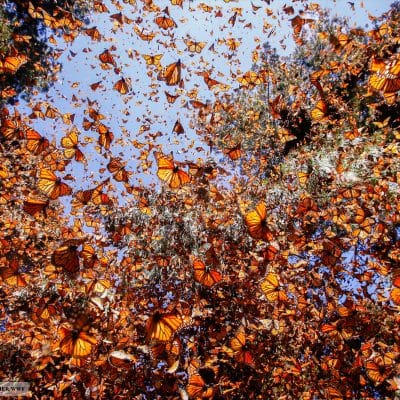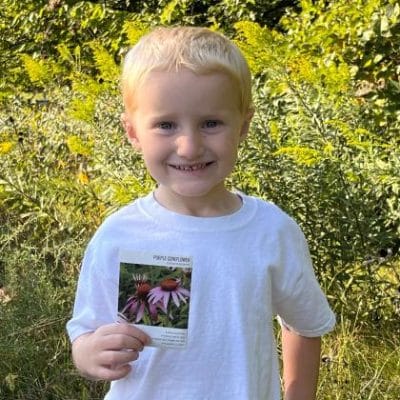

2023-2024 Overwintering population declined another 59% since last year. This year’s eastern monarch population occupied only 0.9 hectares (2.2 acres) at their overwintering site. This is the second lowest number counted since monarch populations began being monitored more than 30 years ago – the lowest was 0.67 ha during the 2013–2014 overwintering season.
View World Wildlife Fund’s official article here.

JEFFERSON CITY, Mo., Sept. 20, 2022 – Pollinators play a critical role in the production of most fruits and vegetables, and a great way to support them is by planting native plants. Bayer is helping the cause by giving away free native-plant seed packets through a new partnership with the Missouri Department of Conservation (MDC).
Read moreSocial
media
moformonarchs
Species Spotlight - "Pipevine Swallowtail"![]()
![]() Habitat
Habitat![]() • Pipevine swallowtails habitat is diverse, from woodlands, forests, open fields, roadsides, and streamsides.
• Pipevine swallowtails habitat is diverse, from woodlands, forests, open fields, roadsides, and streamsides.![]()
![]() Host Plant
Host Plant![]() • The Pipevine Swallowtail is named for its host plant, the pipevine (Aristolochia spp.), which is toxic to its predators, but not its larvae.
• The Pipevine Swallowtail is named for its host plant, the pipevine (Aristolochia spp.), which is toxic to its predators, but not its larvae.![]()
![]() • A native host plant species found in Missouri is Dutchman’s Pipe (Aristolochia tomentosa).
• A native host plant species found in Missouri is Dutchman’s Pipe (Aristolochia tomentosa). ![]()
![]() Life Cycle
Life Cycle![]() • Pipevine Swallowtails lay their eggs on the stems or leaves of the pipevine plant.
• Pipevine Swallowtails lay their eggs on the stems or leaves of the pipevine plant.![]()
![]() • Larvae ingest the toxic chemicals of its host plant which acta as a defense against predators.
• Larvae ingest the toxic chemicals of its host plant which acta as a defense against predators.![]()
![]() • They over-winter in their chrysalis, emerging the following spring when the temperature warms, signaling the air is warm enough for their flight muscles to work.
• They over-winter in their chrysalis, emerging the following spring when the temperature warms, signaling the air is warm enough for their flight muscles to work.![]()
![]() Bonus Fact
Bonus Fact![]() • Four butterflies in Missouri use “mimicry” of the Pipevine Swallowtail as a defense mechanism: Red-Spotted Purple, Black Swallowtail, Spicebush Swallowtail, and the dark form of the (female) Tiger Swallowtail. These butterflies are not toxic to predators, but based on appearance, the predators assume they are.
• Four butterflies in Missouri use “mimicry” of the Pipevine Swallowtail as a defense mechanism: Red-Spotted Purple, Black Swallowtail, Spicebush Swallowtail, and the dark form of the (female) Tiger Swallowtail. These butterflies are not toxic to predators, but based on appearance, the predators assume they are.
Quote of the Week![]()
![]() "Don't judge each day by the harvest you reap, but by the [native] seeds that you sow." - Robert Louis Stevenson
"Don't judge each day by the harvest you reap, but by the [native] seeds that you sow." - Robert Louis Stevenson
Species Spotlight | "Regal Fritillary"![]()
![]() Status
Status![]() • Regal fritillary (Western subspecies) is currently a “Proposed Species” by USFWS for being listed as “Threatened” under the U.S. Endangered Species Act.
• Regal fritillary (Western subspecies) is currently a “Proposed Species” by USFWS for being listed as “Threatened” under the U.S. Endangered Species Act.![]()
![]() Habitat
Habitat![]() • Regal fritillary butterflies live in tall-grass prairie and other open and sunny locations such as damp meadows, marshes, and wet fields.
• Regal fritillary butterflies live in tall-grass prairie and other open and sunny locations such as damp meadows, marshes, and wet fields.![]()
![]() Host Plant
Host Plant![]() • Violets are the sole larval host plant, although regal fritillaries will use various species of violets, including Missouri’s native violets: birdfoot violet (Viola pedata) and prairie/larkspur violet (Viola pedatifida).
• Violets are the sole larval host plant, although regal fritillaries will use various species of violets, including Missouri’s native violets: birdfoot violet (Viola pedata) and prairie/larkspur violet (Viola pedatifida).![]()
![]() Bonus Facts
Bonus Facts![]() • Males have orange spots on their top-hindwings; whereas, females have white spots. (See Images 2-3)
• Males have orange spots on their top-hindwings; whereas, females have white spots. (See Images 2-3)![]()
![]() • Regal Fritillary overwinter locally in the organic layers of soil and detritus.
• Regal Fritillary overwinter locally in the organic layers of soil and detritus.![]()
![]() Photo Credits
Photo Credits![]() Main Image | Madison Ferner/Pennsylvania Department of Military and Veterans Affairs
Main Image | Madison Ferner/Pennsylvania Department of Military and Veterans Affairs![]() Image 2 (Female) | Pennsylvania Army National Guard
Image 2 (Female) | Pennsylvania Army National Guard![]() Image 3 (Male) | Donna Brunet, Missouri Department of Conservation
Image 3 (Male) | Donna Brunet, Missouri Department of Conservation
Get a head-start on your Spring plantings by scattering native wildflower seeds now!![]()
![]() It's a great time to mimic nature by simply dropping seeds on top of snow and allowing them to naturally work their way into contact with the soil below...the same way birds and winds help "sow" our native seeds throughout the winter months.
It's a great time to mimic nature by simply dropping seeds on top of snow and allowing them to naturally work their way into contact with the soil below...the same way birds and winds help "sow" our native seeds throughout the winter months. ![]()
![]() Photo Credit: Nancy Brandt
Photo Credit: Nancy Brandt
𝐃𝐞𝐚𝐝𝐥𝐢𝐧𝐞 𝐉𝐚𝐧𝐮𝐚𝐫𝐲 𝟐𝟒: 𝟐𝟎𝟐𝟓 𝐌𝐏𝐅 𝐏𝐫𝐚𝐢𝐫𝐢𝐞 𝐆𝐚𝐫𝐝𝐞𝐧 𝐆𝐫𝐚𝐧𝐭𝐬 𝐏𝐫𝐨𝐠𝐫𝐚𝐦![]()
![]() The Missouri Prairie Foundation (MPF) Prairie Garden Grants Program is accepting applications for 2025 grant awards until January 24, 2025.
The Missouri Prairie Foundation (MPF) Prairie Garden Grants Program is accepting applications for 2025 grant awards until January 24, 2025. ![]()
![]() Gardening and other conservation groups, parks, schools, and other entities in Missouri and immediately surrounding states are invited to submit proposals to MPF’s Prairie Garden Grants Program. In 2025, MPF would like to award several grants to help fund the establishment or improvement of prairie gardens or plantings using Midwest native plants. Grants will not exceed $800 each. Those with smaller projects are encouraged to apply as well. Matching funds are not required, but proposals with secured matching funds may be evaluated higher than others.
Gardening and other conservation groups, parks, schools, and other entities in Missouri and immediately surrounding states are invited to submit proposals to MPF’s Prairie Garden Grants Program. In 2025, MPF would like to award several grants to help fund the establishment or improvement of prairie gardens or plantings using Midwest native plants. Grants will not exceed $800 each. Those with smaller projects are encouraged to apply as well. Matching funds are not required, but proposals with secured matching funds may be evaluated higher than others.![]()
![]() Funding will be dispersed in February. See more details on the grant and access the application form here: ow.ly/ywLo50Uc8NB
Funding will be dispersed in February. See more details on the grant and access the application form here: ow.ly/ywLo50Uc8NB![]()
![]() 𝑃ℎ𝑜𝑡𝑜 𝑜𝑓 𝑙𝑎𝑡𝑒 𝑠𝑢𝑚𝑚𝑒𝑟 𝑐𝑜𝑙𝑜𝑟 𝑎𝑡 𝑡ℎ𝑒 𝑊𝑜ℎ𝑙𝑤𝑒𝑛𝑑 𝐸𝑙𝑒𝑚𝑒𝑛𝑡𝑎𝑟𝑦 𝑛𝑎𝑡𝑖𝑣𝑒 𝑝𝑙𝑎𝑛𝑡 𝑔𝑎𝑟𝑑𝑒𝑛, 𝑒𝑠𝑡𝑎𝑏𝑙𝑖𝑠ℎ𝑒𝑑 𝑤𝑖𝑡ℎ 𝑎𝑛 𝑀𝑃𝐹 𝑃𝑟𝑎𝑖𝑟𝑖𝑒 𝐺𝑎𝑟𝑑𝑒𝑛 𝐺𝑟𝑎𝑛𝑡 𝑖𝑛 2023, 𝑏𝑦 𝐷𝑎𝑣𝑒 𝑀𝑒𝑠𝑐ℎ𝑘𝑒
𝑃ℎ𝑜𝑡𝑜 𝑜𝑓 𝑙𝑎𝑡𝑒 𝑠𝑢𝑚𝑚𝑒𝑟 𝑐𝑜𝑙𝑜𝑟 𝑎𝑡 𝑡ℎ𝑒 𝑊𝑜ℎ𝑙𝑤𝑒𝑛𝑑 𝐸𝑙𝑒𝑚𝑒𝑛𝑡𝑎𝑟𝑦 𝑛𝑎𝑡𝑖𝑣𝑒 𝑝𝑙𝑎𝑛𝑡 𝑔𝑎𝑟𝑑𝑒𝑛, 𝑒𝑠𝑡𝑎𝑏𝑙𝑖𝑠ℎ𝑒𝑑 𝑤𝑖𝑡ℎ 𝑎𝑛 𝑀𝑃𝐹 𝑃𝑟𝑎𝑖𝑟𝑖𝑒 𝐺𝑎𝑟𝑑𝑒𝑛 𝐺𝑟𝑎𝑛𝑡 𝑖𝑛 2023, 𝑏𝑦 𝐷𝑎𝑣𝑒 𝑀𝑒𝑠𝑐ℎ𝑘𝑒


